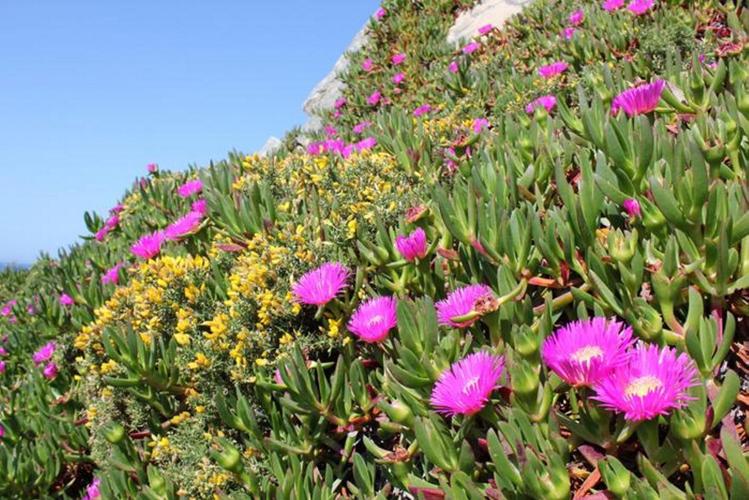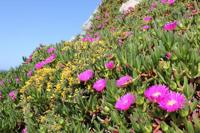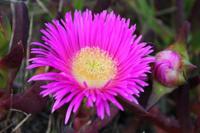
Carpobrotus plants competing for space and pollinators with the native gorse Ulex europaeus in the Tower of Hércules Natural Reserve, A Coruña, Spain. (Jonatan Rodríguez / USC via SWNS)
By Stephen Beech
One of the world's most destructive plants is being tracked using vacation snaps posted on Instagram.
The photos reveal how the “highly harmful” invasive species is taking over new environments by extending its flowering season and threatening native biodiversity, say scientists.
An Irish-led international research team analysed more than 1,700 photographs from social media and citizen science platforms to track Carpobrotus species - commonly known as ice plants or sour fig – across South Africa, Argentina, New Zealand, Portugal, Spain and the United States.
The fleshy evergeen succulent plants are native to South Africa, but now smother coastal ecosystems from California to the Mediterranean and transform ecosystems.
A single Carpobrotus plant can cover up to 50 square metres (538 square feet), suffocating everything beneath it.
They change soil chemistry and monopolise pollinators with their bright pink and yellow flowers - disrupting local ecosystems, say scientists.
Study lead author Dr. Susan Canavan, from the University of Galway, said: "We realised thousands of people were unknowingly documenting these invasions in the background of their beach selfies and cliff-top sunset photos.
"This gave us observers across the globe, from California's Big Sur to New Zealand's coastlines to Portugal's tourist beaches.”

Open flower and a bud of Carpobrotus in the Tower of Hércules Natural Reserve, A Coruña, Spain. (Jonatan Rodríguez / USC via SWNS)
She says California's tourist hotspots provided nearly three times more usable photos than other regions, while remote locations in South Africa and the Azores relied entirely on dedicated naturalist platforms such as iNaturalist.
The team discovered that the Carpobrotus populations flower longer than native ones, potentially producing more seeds and increasing their spread.
In their native South Africa, the plants show a short, concentrated flowering peak but in invaded regions, they bloom across extended periods. This reproductive advantage may help to explain their invasive success.
The findings, published in the journal Ecological Solutions and Evidence, show that local environmental conditions override genetic differences in determining flowering timing.
The plants adapt to bloom during the local spring season, such as October in New Zealand and May to June in California and Europe, rather than maintaining the flowering patterns from their native range.
For coastal managers battling the invaders, the findings offer practical guidance - by revealing peak flowering times in the invaded regions, the research will help them to time removal efforts to prevent seed production.
Dr. Canavan said: "Tourist destinations were goldmines of data.
"Every scenic overlook with Carpobrotus had hundreds of Instagram posts.

Carpobrotus invasion at Duna do Caldeirão, Vila Praia de Âncora, Portugal. (Jonatan Rodríguez / USC via SWNS)
"But this also showed us the bias in social media data.
"Remote invaded areas remain invisible without citizen scientists actively documenting them."
She added: “The study also demonstrates how the digital age is transforming ecological research.
"What began as vacation photos and nature observations has become a powerful tool for tracking biological invasions.”
Co-author Dr. Ana Novoa, from the Czech Academy of Sciences, said: "These plants are notoriously difficult to control because they spread both by seed and by fragments.
"Even a small piece can regrow into a new colony.
"Knowing exactly when they flower in each region means we can strike when they're most vulnerable, before they produce the thousands of seeds that ensure next subsequent invasions."



















(0) comments
Welcome to the discussion.
Log In
Keep it Clean. Please avoid obscene, vulgar, lewd, racist or sexually-oriented language.
PLEASE TURN OFF YOUR CAPS LOCK.
Don't Threaten. Threats of harming another person will not be tolerated.
Be Truthful. Don't knowingly lie about anyone or anything.
Be Nice. No racism, sexism or any sort of -ism that is degrading to another person.
Be Proactive. Use the 'Report' link on each comment to let us know of abusive posts.
Share with Us. We'd love to hear eyewitness accounts, the history behind an article.